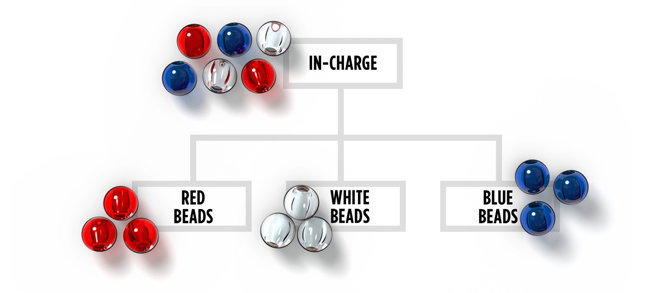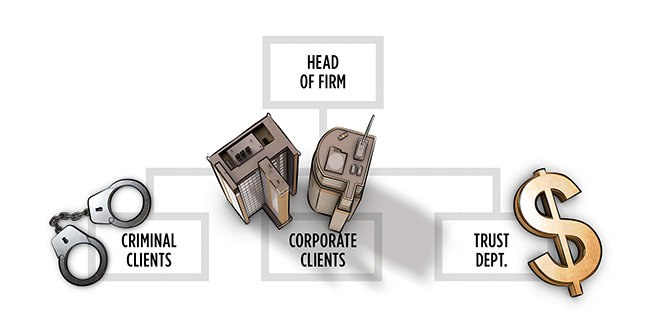Basic Organization
What is organization?
Most people have so many ideas about the word “Organization” that they do not think of it as an activity that involves people working together to get something done.
Let’s see what organization really is.
Let us start by taking a pile of red, white and blue beads that are used to make something. Let’s organize them.
First we draw the Org Board. “Org Board” is not short for organization board but for Organizing Board. An Org Board is a board that shows the orderly arrangement of organizing to produce a product. Again, a product is something completed—a service or item—that can be exchanged.
Organizations and companies produce products—cars, jewelry, clothing, toys, food, etc. Within any organization or company, each person working there produces something.
For example, a receptionist produces calls that are politely answered and transferred to the right person.
A construction worker produces some part of a building, like putting up the walls or laying the floors.
A packer puts whatever the company produces neatly into the right package.
An organizing board is used by an organization to produce its products and so be successful.
Let’s see how it works.
We have a bunch of beads. Let’s dump the beads all on top of the In-Charge, the person in charge, all mixed up in confusion.
Obviously the In-Charge must do something with all these beads or he is going to feel confused himself and unable to deal with this confusion. So he has to route the beads—send them on a particular path or channel. One way he can do this is by first separating them into types: red beads, white beads and blue beads.
It will look like this:

This is what a person in charge in any organization, company or activity has to do. He routes. He separates things that come to him into types or classes of thing or classes of action.
But so far the beads have just been put in their types—red, white and blue.
They haven’t gone anywhere.
Again, an organization has to produce something. Let’s say the organization’s products are drilled, strung and boxed beads. We would get this:

Or we would get:

Or we would get:

It is not particularly important which pattern of Org Board we use so long as it handles the amount of beads.
If we only have one person in this “organization,” he would still have to have some idea of organization and a sort of Org Board.
But if we have any large numbers of people or things to handle, we have to add people to get the job done. However, if we just add people without an Org Board, we will also add a lot of confusion.
An organization without an Org Board will break down because of having more work than it can easily handle. The result will be a confusion.
What is a confusion? A confusion is a flow of particles (people, communications or other items) that has no arrangement or order. Things run into and bounce off each other and stay IN the area. They don’t go out anywhere.
There is no product, because to have a product something must flow OUT. If a company makes clothing, the clothes that the company produces have to be sent OUT, for example, to another company that is then going to sell the clothes to people.
We can now see two things. We have some stable items. These are locations or jobs or positions in a group or organization. And we have things that flow. These are the things that are being changed by the people who have the job or position.
Using the example of a company that makes clothing, it might work like this:
Raw cloth is delivered to the company. Someone has to cut it. That’s his
Then he sends it along to someone else and that person’s job is to sew the cloth and make a shirt—shirt maker. So that employee has made another change.
Then he sends the shirt along to another employee who sews the buttons on the shirt—button sewer. Another change.
The completed shirt now goes to the packager who packages the shirt.
At each point , the things (cloth and then shirts) moving through this clothing company have been changed, until they are completed products.
The final product of the company—packaged, high-quality shirts ready for sale—can now be sold to another company, such as a department store, which is then going to sell the shirts to people who need or want shirts.
So any organization or company’s employees change flowing particles.
Particles flow in sequence.
Things enter an organization, get changed, flow out of an organization.
An organization with one type of item only, such as red beads, is less complex than one with several types of items:

Any activity has a sequence of actions. It has to have points that are stable—the people on the jobs that do the work—and do not flow in order to handle things which do flow.
It is not necessary to have the people who are at stable points do only one thing. But it does have to have an exact, correct sequence of actions.
All this is true for a ship’s engine room or a lawyer’s office, or any organization.
For example, in a ship’s engine room, the fuel flows in and is changed to motion (power) which flows out.
Someone runs the machines. Someone repairs the machines. It may all be done by one person but as soon as volume goes up, someone has to plan out the actions, separate them into different types and put them on an Org Board.
This is done by dividing operation and repair into two actions, making two activities on the same Org Board.
The Chief Engineer keeps the flows going and the motormen doing their work.
In a lawyer’s office we get different actions as a flow.
The above would be a flow arrangement, possibly with a different person (with a different skill) on each point.
Or we could have an Org Board where things do not move anywhere.

But if we did that we would have to place things on the Org Board starting at the top of each section, showing the different actions to be done and working down, continuing to list each of the actions.
In this way a flow would occur through the various people on the Org Board. It would look like this:

Organizing Boards which only give the names of various positions usually will not flow or work well.
A typical army Org Board of the past was:

But as armies got a lot more men they had to have an Org Board that showed the flows of things.

So you organize by doing these steps:
1. Carefully looking over the types of particles—the things involved in producing a product.
2. Working out the changes that must be done for each type of particle to make a product.
3. Hiring and putting on the Org Board the people who will do the changing in the sequence of changes laid out on the board.
The board also must include a recognition of the types of particles in number 1 above.
It must also include the routing of the different types of things to the people who change them. Finally there is a further routing out as products.
For example, the receptionist in a company has to be able to recognize the different types of visitors coming to her desk. A delivery man would be routed to the person who receives deliveries. A potential customer would be routed to a salesman. And so on.
To be workable and usable, an Org Board must also include getting the materials and supplies needed to produce. It must have ways to get the organization’s product out to people who may want it , such as having advertising and salesmen. It has to be paid for the products it produces. It also has to have people to supervise the work.
A company is basically a collection of small Org Boards combined to operate together as a large Org Board.
To plan out any activity you want to do, you have to be able to do these simple steps:
1. Visualize (form a picture in your mind) the sequence of flows and the changes that have to happen at each point.
2. Be able to see where a particle (paper, body, money, etc.) comes in and where it leaves your activity, company, etc.
3. Be able to locate any point where things have stopped and aren’t working and do something to fix that part of the flow.
In summary, a proper Org Board is a continuing combination of flows of things which do not bump into one another and which do enter and do experience the desired change and which do leave as products.

